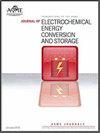基于神经网络的锂离子电池中空圆柱纳米电极扩散应力建模
IF 2.7
4区 工程技术
Q3 ELECTROCHEMISTRY
Journal of Electrochemical Energy Conversion and Storage
Pub Date : 2024-05-20
DOI:10.1115/1.4065536
引用次数: 0
摘要
了解机械变形与质量输运(如扩散诱导应力)之间的相互作用对于开发先进的电池材料和电化学装置至关重要。数学建模和耦合问题的求解在推进对机械变形和质量输运之间相互作用的理解方面发挥了重要作用。随着数学建模的复杂性不断增加,用于解决相关耦合问题的数值方法也可能遇到重大挑战。这项研究探索了通过深度学习技术设计神经网络的可行性,该网络专门用于解决锂离子电池电极中的扩散诱导应力问题。根据求解域内采样点的时空坐标、偏微分方程系统的整体结构、边界条件和初始条件构建损失函数。得到了中空圆柱形纳米电极中的应力和锂浓度分布。数值结果与有限元法的结果高度一致。本文章由计算机程序翻译,如有差异,请以英文原文为准。
Neural Network-Based Modeling of Diffusion-Induced Stress in a Hollow Cylindrical Nano-Electrode of Lithium-Ion Battery
Understanding the interaction between mechanical deformation and mass transport, such as diffusion-induced stress, is crucial in the development of advanced battery materials and electrochemical devices. Mathematical modeling and solving the coupling problems have played important roles in advancing the understanding of the interaction between mechanical deformation and mass transport. As the complexity of mathematical modeling continues to increase, numerical methods used to solve the related coupling problems are likely to encounter significant challenges. This work explores the feasibility of designing a neural network specifically for solving diffusion-induced stress in the electrode of lithium-ion battery via deep learning techniques. A loss function is constructed from the spatiotemporal coordinates of sampling points within the solution domain, the overall structure of the system of partial differential equations, boundary conditions, and initial conditions. The distributions of stress and lithium concentration in a hollow-cylindrical nanoelectrode are obtained. The high degree of conformity between the numerical results and those from finite element method is demonstrated.
求助全文
通过发布文献求助,成功后即可免费获取论文全文。
去求助
来源期刊

Journal of Electrochemical Energy Conversion and Storage
Engineering-Mechanics of Materials
CiteScore
4.90
自引率
4.00%
发文量
69
期刊介绍:
The Journal of Electrochemical Energy Conversion and Storage focuses on processes, components, devices and systems that store and convert electrical and chemical energy. This journal publishes peer-reviewed archival scholarly articles, research papers, technical briefs, review articles, perspective articles, and special volumes. Specific areas of interest include electrochemical engineering, electrocatalysis, novel materials, analysis and design of components, devices, and systems, balance of plant, novel numerical and analytical simulations, advanced materials characterization, innovative material synthesis and manufacturing methods, thermal management, reliability, durability, and damage tolerance.
 求助内容:
求助内容: 应助结果提醒方式:
应助结果提醒方式:


